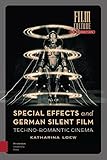Special Effects and German Silent Film : Techno-Romantic Cinema / Katharina Loew.
Material type: TextSeries: Film Culture in TransitionPublisher: Amsterdam : Amsterdam University Press, [2021]Copyright date: ©2021Description: 1 online resource (320 p.)Content type:
TextSeries: Film Culture in TransitionPublisher: Amsterdam : Amsterdam University Press, [2021]Copyright date: ©2021Description: 1 online resource (320 p.)Content type: - 9789048551712
- Cinematography -- Germany -- Special effects -- History
- Silent films -- Germany -- History and criticism
- Film Studies
- Film, Media, and Communication
- Media Studies
- Science and Technology
- Transnational and Global Studies
- ART / History / Modern (late 19th Century to 1945)
- special effects, German cinema, silent cinema, film style, technology
- 791.430943 23
- online - DeGruyter
| Item type | Current library | Call number | URL | Status | Notes | Barcode | |
|---|---|---|---|---|---|---|---|
 eBook
eBook
|
Biblioteca "Angelicum" Pont. Univ. S.Tommaso d'Aquino Nuvola online | online - DeGruyter (Browse shelf(Opens below)) | Online access | Not for loan (Accesso limitato) | Accesso per gli utenti autorizzati / Access for authorized users | (dgr)9789048551712 |
Frontmatter -- Table of Contents -- Acknowledgements -- Introduction: Special Effects and the Techno-Romantic Paradigm -- 1. Imagining Technological Art: Early German Film Theory -- 2. Modern Magicians: Guido Seeber and Eugen Schüfftan -- 3. The Uncanny Mirror: Der Student von Prag (1913) -- 4. Visualizing the Occult: Nosferatu (1922) -- 5. The Technological Sublime: Metropolis (1927) -- 6. “German Technique” and Hollywood -- Conclusion: Techno-Romantic Cinema from the Silent to the Digital Era -- Bibliography -- Index
restricted access online access with authorization star
http://purl.org/coar/access_right/c_16ec
One of the most famous special-effects sequences in the history of cinema is the robot's anthropogenesis in Metropolis. The scene has become an emblem for the astonishing technical and aesthetic achievements of German filmmakers. Not only did special effects shape the look of many iconic films, they are also central to a comprehensive understanding of German silent film culture. Employed to visualize ideas and emotions in a medium-specific way, special effects demonstrated technology's creativity and ability to transcend physical reality. By so doing, they played a decisive role in the evolution of cinematic expressivity. Special effects embody "techno-romantic" lines of thought, a concept that describes efforts to harness technology, the epitome of modern materialism, for the purpose of accessing a spiritual realm. While special effects have been mainly considered as spectacles or practical tools to date, this book foregrounds their function as an artistic device.
Mode of access: Internet via World Wide Web.
In English.
Description based on online resource; title from PDF title page (publisher's Web site, viewed 01. Dez 2022)


